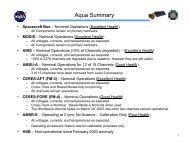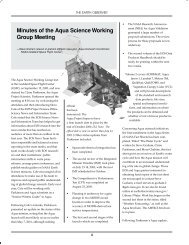CERES - Aqua - NASA
CERES - Aqua - NASA
CERES - Aqua - NASA
You also want an ePaper? Increase the reach of your titles
YUMPU automatically turns print PDFs into web optimized ePapers that Google loves.
Science Priorities<strong>CERES</strong> is focused on four important Earth Science Enterprise priorities for understanding the total Earthsystem and the effects of natural and human-induced changes on the global environment.Long-Term Climate VariabilityRadiation and clouds strongly influence our weather and climate. For example, low, thick clouds reflectincoming solar radiation back to space causing cooling. High clouds trap outgoing infrared radiation and producegreenhouse warming. The Earth Radiation Budget Experiment (ERBE), which was launched on multiplesatellites in the mid 1980s, has provided critical data that indicate that clouds have an overall net coolingeffect on the Earth (i.e., negative net cloud forcing in the figure below). The largest negative cloud forcing isfound over the storm tracks at high-to-middle latitudes in the summer hemisphere. The most extreme valuesoccur over marine areas, since the contrast in albedo between clear and cloudy conditions is greatest overoceans. In the tropics, the longwave and shortwave cloud forcings nearly cancel; therefore clouds have neithera heating nor cooling effect in these areas. Much more information is needed about clouds and radiation andtheir role in climate change. The largest uncertainty in climate prediction models is how to determine theradiative and physical properties of clouds. <strong>CERES</strong> observations will contribute to improving the scientificunderstanding of the mechanisms and factors that determine long-term climate variations and trends.Net Cloud Forcing from ERBEJuly 1987no data -140 -120 -100 -80 -60 -40 -20 0 20 40Cooling Watts/meter 2 Warming5





